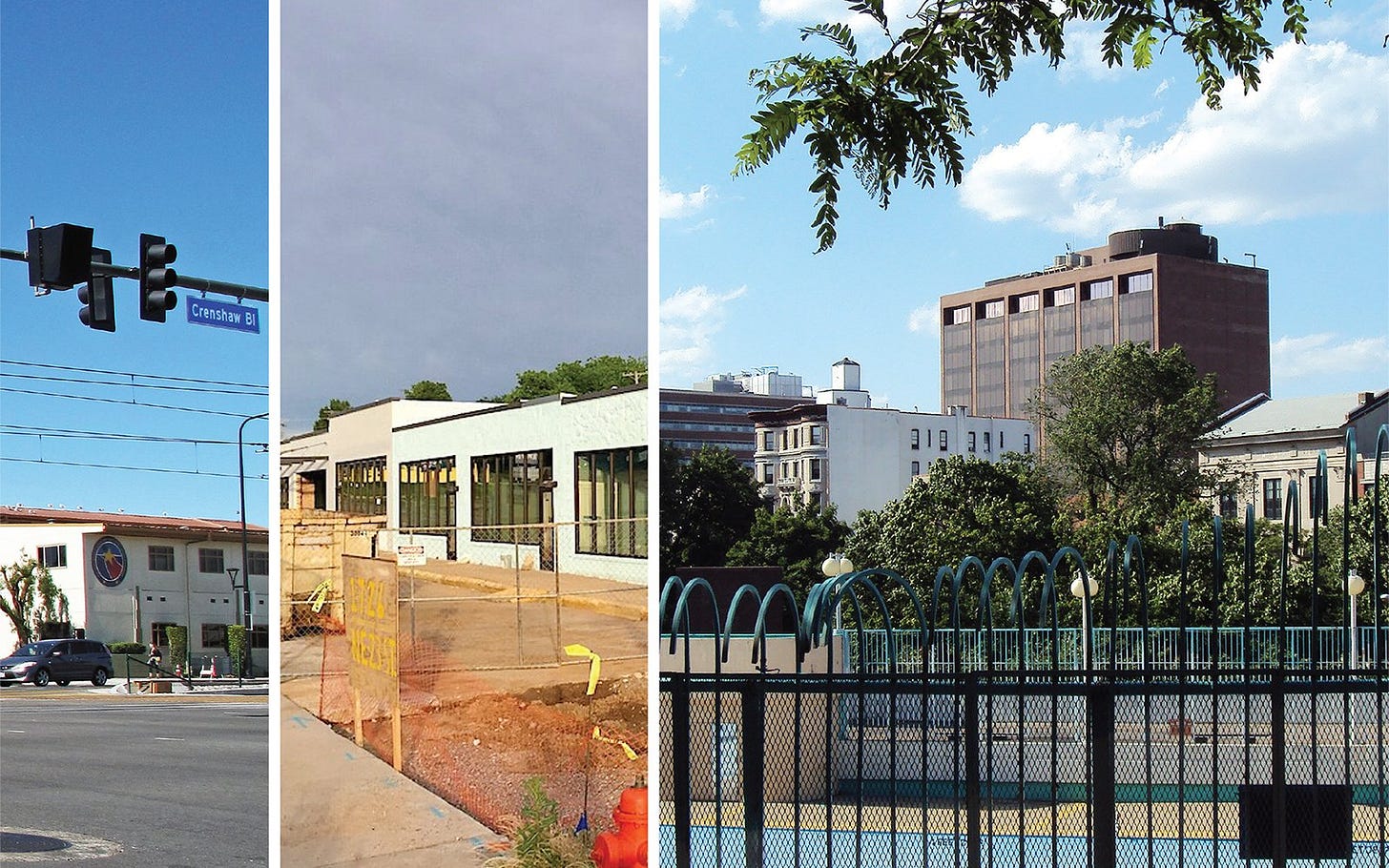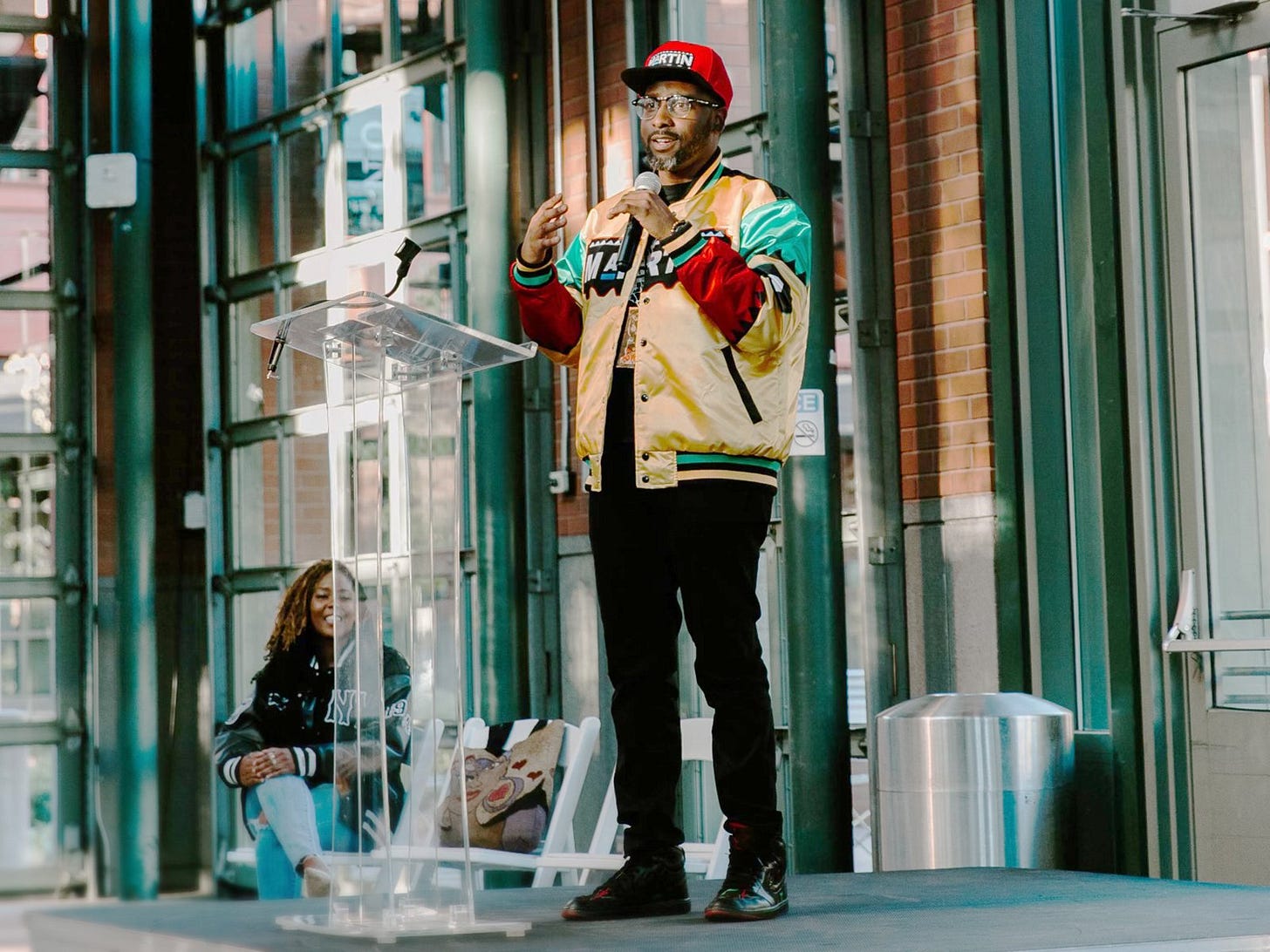CITYBUILDING | Black Citybuilding
Why I started the Congressional Black Caucus for New Urbanism.
Written By Bruzenskey Bois
This piece was originally printed in Issue 1 of Southern Urbanism Quarterly.
If we look around, the link between the built environment and racial equity is clear. One night, I was driving through what was one of Tampa’s historic Black neighborhoods. I could see the bones and structure of where a Black community used to thrive. Commercial buildings came up to the sidewalk. Every structure had large windows facing the street. I thought to myself, “It would be nice to see patrons walking on these sidewalks again, going from business to business. But how safe would they feel with me driving past on this three-lane, one-way road going 50 miles per hour?” And not only that—as a driver, I wouldn’t even have a chance to notice the businesses I was passing. I could try to pay more attention to them, but at that speed, it wouldn’t be safe. “No way businesses in this neighborhood can flourish with this setup,” I thought. I imagined what the local economy would be like if that road went away. The ideas of community, opportunity, beauty, and pride were absolutely applicable to the neighborhoods I knew. But in those neighborhoods, those ideas couldn’t survive. That’s why I started the Black Caucus.
With the Black Caucus, I choose to create lasting change through placemaking.
For years, I had struggled with the question: How can Black people combat systemic racism in today’s society? To be honest, I’m not sure how far marching and posting hashtags will get us and for how long. Those things help, but I believe they are only part of what we can do. So now, the answer to my question is simple: The Congressional Black Caucus for New Urbanism (CBCNU) is the vehicle I will use to combat systemic racism—to advance people of color through the built environment. With the Black Caucus, I choose to create lasting change through placemaking.
I decided to start the Black Caucus after a conversation with my mentor, the architect and developer Frank Starkey. When I joined his company, People Places, in 2019, Frank’s vision, passion, and love for placemaking made me gravitate toward him immediately. He introduced me to this world and to the Congress for the New Urbanism (CNU). Right away, I started to get active with the organization and joined various committees, including the PLACE Initiative (Proactive Leadership Advocating for Climate & Equity). I also learned about the Christian Caucus, the other CNU chapters, and its other subgroups. But there wasn’t a Black Caucus. Most of the time, I found that I was the only Black guy in the room.
It did take some time and thought to arrive at creating the Black Caucus. Earlier on, I heard from many members of the Black community that CNU wasn’t diverse enough. Others believed that CNU sometimes provided what amounted to a handout for its Black members, not an opportunity for independence. All these perspectives were valid, and all were someone’s truths. But I wasn’t necessarily bothered by being the only Black guy in the room, and I didn’t feel like I was asking for a seat at someone else’s table—an issue that arose for some around me. My perspective was and is that I am here to learn and serve.
When I asked Frank to point me in the right direction, I can remember him saying, “We don’t have a Black Caucus, but you should create one.” At that moment, a light bulb went off.
How do we become part of the development process of the places we call home?
I had just completed the last pages of The Color of Law, a book that was so pivotal to me after a lifetime of hearing facts and theories from my elders. The Color of Law put those stories and information into context, and it helped crystallize what I needed to do next.
Today, the Black Caucus is a tool to remove the word “they” from Black and Brown conversations about detrimental changes happening in our own neighborhoods. No longer will we allow “them” to plan for the future of where we live.
Instead, we will replace “they/them” with “we/us.” How do we become part of the development process of the places we call home? This shift means the dialogue is no longer about what is happening to us—it’s about what we are doing in our cities for ourselves.
Sure, there are plenty of Black developers. But how many of them are aware of each other? How many of them share the same networks? How many Black architects do we have? Black planners? Black municipal employees? Black engineers and property managers? Black business owners? What about Black towns—old and new?
What if we did have a Wakanda? Would we then be able to combat some of the systemic racism that we experience today?
One of the challenges I run into is explaining that the Black Caucus’s mission does not involve asking for a seat at the table. Instead, we’re using the knowledge of our allies and enemies to build our own table. At the Black Caucus, we do support the values of CNU. But we aren’t just out to ensure that CNU maintains its mission of diversity and equity. We’re here to hold ourselves accountable and learn the tools we need for the advancement of Black and Brown people. Our goal is to educate people of color on how to participate in the development process, instruct them through project-led initiatives, and get more developers and skilled professionals within our community to actively build cities.
Nipsey Hussle is my favorite New Urbanist. We can learn a lot from what he did in the Crenshaw District of Los Angeles. There, he was able to purchase a commercial building and change out the businesses that were currently there for businesses owned by people from the community, which in turn better served the community.
When I began working to get the Black Caucus off the ground, I knew it would be essential to understand the path of those who came before me and that of others who are currently active. I discovered that I wasn’t the only person to attempt to tackle CNU’s diversity problem. This is not to say that others had failed, but rather that my predecessors were worthy of study. In my eyes, they were superheroes. I thought, “How can I align myself with them?” By the time I came along—in the wake of George Floyd and the climate created by the Black Lives Matter movement—more people in CNU sought to have the conversation and take actionable steps. I would like to think that my approach will be different. I also know I must pay homage to the many people before me who have sought to be ambassadors for diversity and equity in citybuilding.
It’s also important to look around at other communities and projects that have already shown us the way. For example, Nipsey Hussle is my favorite New Urbanist. We can learn a lot from what he did in the Crenshaw District of Los Angeles. There, he was able to purchase a commercial building and change out the businesses that were currently there for businesses owned by people from the community, which in turn better served that community. Today, we see the revitalization of Oklahoma City’s Eastside led by Councilwoman Nikki Nice and others. In Harlem, Councilwoman Kristin Jordan and others like her are making a difference by taking a page from Jane Jacobs and ensuring that there is affordable and adequate housing for the people of that neighborhood. And in Tullahassee, Oklahoma—the state’s oldest Black town—Mayor Keisha Currin is revitalizing the city where she grew up. The Caucus is a diverse group of people who are developing their own neighborhoods. They are not waiting on “them” to make a difference.
I am sure there are many other communities and undertakings like these, but there aren’t enough channels to connect Black professionals with the projects that are being led by Black developers, for Black people. Earn Your Leisure and BlackSpace are two organizations that get it. When we become more aware of each other’s efforts, we can share ideas and work together. It’s my vision that the Black Caucus will serve as the place where community thought leaders and project leaders can do just that.

What do we have in mind? The Black Wall Streets in Tulsa, Oklahoma, and Durham, North Carolina, were successful partly because of the built environment. Let’s focus on remaking these places by developing new land and rejuvenating historic Black neighborhoods, towns, and cities. Let’s work with organizations like Black Towns Municipal Management, led by CEO Cymone Davis, and Next Leadership Development Corporation, led by Executive Director Dr. Atyia Martin, who together developed the nation’s first-ever geographic information system (GIS) tool for mapping Black towns.
Over the next year, the Black Caucus will focus on letting people know who we are and what we are about. We’ll also be getting aligned with strategic partners. (You don’t have to be Black to be a partner, but you do have to care about diversity, equity, and the advancement of Black and Brown people.) In years two and three, we would like to see Black neighborhoods, towns, and cities breaking ground—physically and socially. In years three and four, we want to be able to see a GIS map full of Black communities being developed throughout the country. By year 10, we aim to see 50 Black New Urbanist projects across the country—at least one in every state.
This is why I started the Black Caucus. So let’s work together—to reform racist zoning laws, to learn from our ancestors, to build more places for our people and our children.
Bruzenskey Bois is the founder of the Congressional Black Caucus for New Urbanism (CBCNU). You can find him on Twitter @Bruzenskey.

